To the lecture series English top page
Comments on Lecture 24 "Illusion That Might Be Caused by Depth Perception"
Comment 1. Answer to question 1"
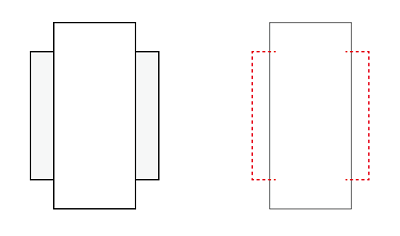 This picture can be interpreted as two objects and the nearer object hides part of the father object. Therefore, similar to the Poggendorff illusion, the rear object has narrow areas that is visible only from one of the eyes, and hence these areas are regarded as being behind the nearer object, as shown by red borken lines. As the result, the farther object appears to be shrunk horizontally than what really is.
This picture can be interpreted as two objects and the nearer object hides part of the father object. Therefore, similar to the Poggendorff illusion, the rear object has narrow areas that is visible only from one of the eyes, and hence these areas are regarded as being behind the nearer object, as shown by red borken lines. As the result, the farther object appears to be shrunk horizontally than what really is.
Comment 2. Answer to question 2"
[Method 1] See the picture by only one eye.
Let us check whether the Ponzo illusion and the Kanizser illusion disappear when we see them by a single eye. If the illusions disappear, this is consistent with the explanation that the illusions occur because part of the rear object is visible only by a single eye.
[Method 2] Rotate the picture by 90 degrees.
Because our eyes align horizontally, the rear object is partly visible only by a single eye only when the occluding edge is not horizontal. If the illusion disappear when we rotate the picture by 90 degrees, this is consistent with the 3D interpretation of the illusion.
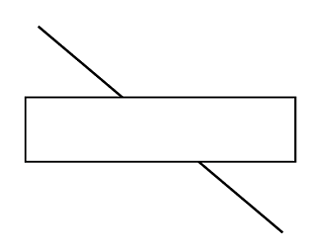
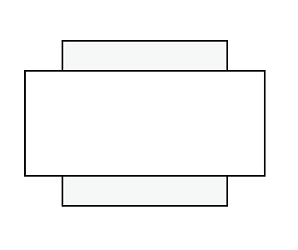
Comment 3. References on 3D interpretation of the ilusions
[3D interpretation of the Muller-Lyer illusion]
R. L. Gregory, The Intelligent Eye. Weidenfeld & Nicolson, London, 1970.
[3D interpretation of the Poggendorff illusion]
H. Ono, N. J. Wade and L. Lillakas, The pursuit of Leonardo's constraint. Perception vol. 31 (2002), pp. 83-102.
[3D interpretation of the Cafe Wall illusion]
K. Maruya and T. Ohtani, Interpretations of the cafe-wall illusion on the basis of 3D scene perception and production of variations (in Japanese). Journal of Graphic Science of Japan, vol. 54 (2020), pp. 13-26.
Comment 4. Explanation of the illusion without 3D interpretation
In the present lecture, we show that some illusions might be explained by assuming that we associate 3D structures when we see 2D pictures although it may be inconciously. However, other explanations in which we do not consider 3D structures are also possible. Let me show that we can explain the Muller-Lyer illusion and the Poggendorff illusion in a unifying manner if we assume that our brains process blurred images.
The Muller-Lyer figure shown in the left is changed to the center figure if it is blurred. If we binarize it by some threshould into the diagram areas and the white background area, we get the right figure. This figure has the medial axes as shown by black curves, where the medial axis is defined as the set of points inside the area that have two or more nearest points on the boundary (the medial axis is also called the skeleton). Comparing the medial axes with the original line drawing, we can see that the horizontal line becomes longer in the upper figure and shorter in the lower figure.
Let us assume that the image is blurred in some part of our brains. Of course our brains try to process the image as precisely as possible. However, the image data is huge and requires much time to process. On the other hand, our brains also want to process the image as quickly as possible in order, for example, to avoid collision with an object flying toward us. For that purpose we need to reduce the data size, i.e., we need to blur the image. So it is reasonalbe to assume that our brains process also a blurred version of the image, although we usually do not notice it conciously.
If we accept this assumption, we can explain the Muller-Lyer illusion by the change of the lengths of the medial axes of the blurred image.
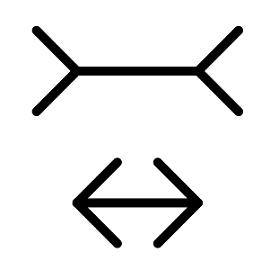
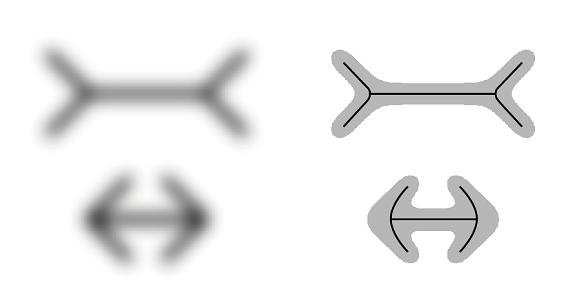
The Poggendorff illusion can be explained similarly. The Poggendorff figure shown in the left changes to the center figure when it is blurred, and we get the medial axes of the line areas as shown in the right. We can see that the accute angles of the medial axes are larger than the original figure, which explains the apparent displacement of the collinear lines.
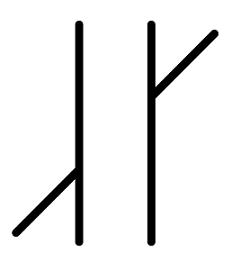
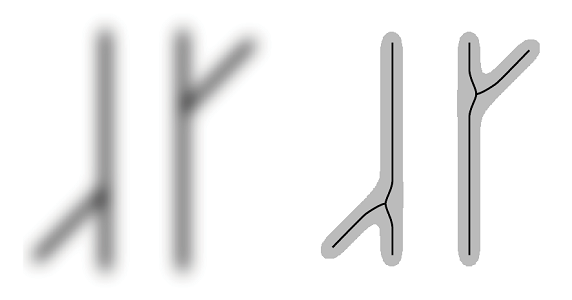
This explanation can be applied to many other illusions such as the Hering illusion, the Zollner illusion and the Ponzo illusion. See the following paper for the details.
K. Sugihara: Skeleton dislocation model for geometric optical illusions. (Submitted to the International Symposium on Voronoi Diagrams and Applications 2014)
(I wrote this paper and submitted to an international conference on some area of computational geometry, but the conference was postponed by some reason and has not yet been held. So the paper has not yet been published.)
There are many other arguments in which the illusions are explained by image blurring. For example, the next paper considers the distortions the boundary lines in the blurred image. This argument can also explain why the cafe-wall illusion occurs.
C. Fermuller and H. Malm, Uncertainty in visual processes predicts geometrical optical illusions. Vision Research, vol. 44 (2004), pp. 727-749.




 This picture can be interpreted as two objects and the nearer object hides part of the father object. Therefore, similar to the Poggendorff illusion, the rear object has narrow areas that is visible only from one of the eyes, and hence these areas are regarded as being behind the nearer object, as shown by red borken lines. As the result, the farther object appears to be shrunk horizontally than what really is.
This picture can be interpreted as two objects and the nearer object hides part of the father object. Therefore, similar to the Poggendorff illusion, the rear object has narrow areas that is visible only from one of the eyes, and hence these areas are regarded as being behind the nearer object, as shown by red borken lines. As the result, the farther object appears to be shrunk horizontally than what really is.

